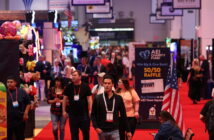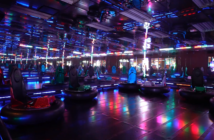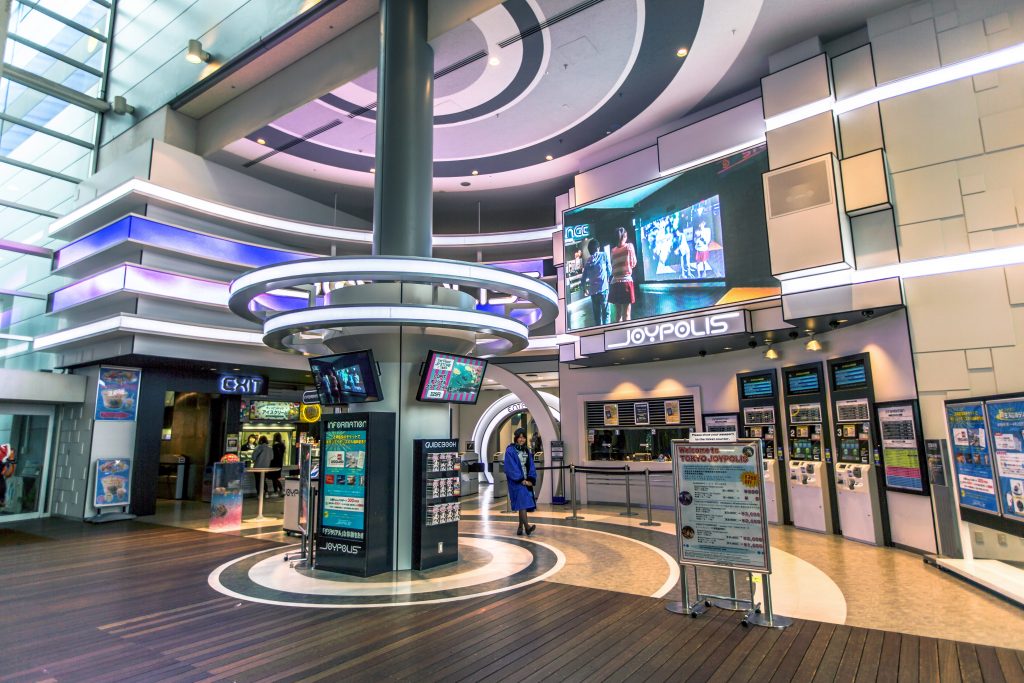
The Sega Joypolis entrance in Tokyo.
Emerging Tech Takes Center Stage
The Amusement Scene Is Buzzing With Developments in VR and More
by Kevin Williams
KWP/The Stinger Report & Founding Chairman of the DNA Association
While still wrapped in nostalgia, the perception many have of the “arcade” and amusement entertainment business in general is as far from the modern reality as possible. There’s been a revolution in the deployment of out-of-home entertainment in recent years that has the capability of dragging the amusement trade toward a startling new future.
The definition of technology-based entertainment platforms encompassed in the term “Digital Out-of-Home Entertainment” (a mouthful so we’ll just call it “DOE”) ranging from video games and videmption pieces to the latest media-based, visitor attractions, million-dollar theme park attractions and much more. This has been encouraged by the Millennial audience demanding a level of entertainment and immersion from what they play out-of-home as they have come to expect from their console games, tablets and smartphones at home.
Within DOE, many key technologies are driving a resurgence in destination-based entertainment that some have called “Arcade 2.0.” One such ubiquitous technology has been Virtual Reality (VR). The revived interest in this immersive tech had originally been driven by consumer adoption of the hardware. But since its mainstream launch last year, some have noted a “gap of disappointment” with potential consumer buyers who have been faced with a complicated and overly expensive process to deploy this emerging technology in their homes. The recognition of this “reality gap” means that VR, for the time being, will be a “Destination Activity” for most players, rather than the original aspiration that players would buy consumer hardware and play at home. This could be great news for the amusement business!
The Asian Dimension
The “pay-to-play” model within FECs, amusement parks and standalone-centers approach to VR has become a defining element in the implementation of the technology in China. These facilities, known as “VR Arcades” or “VR Parks,” have mushroomed over the last three years with a conservative estimate from Forbes that there are over 3,000 such facilities of various types. (More recent estimates have that number exploded to some 15,000 dedicated sites.)
Many of the early Chinese locations were a crude mix of amusement, Internet gaming and VR novelty attractions, but the market has become more solidified, seeing the development of sophisticated brands and franchise operations. An example of the big investment going into this scene was the opening of SoReal VR, a virtual reality theme park in Beijing covering some 32,000-sq.-ft. Located within a large shopping mall, it has a number of specially created VR attractions developed by Sky Limited Entertainment.
The Chinese market has started to expand its interests in the deployment of this entertainment beyond their shores. A major development was the acquisition of 85% of SEGA Sammy at the beginning of the year by China Animation Characters Co. Ltd. (China Animation), a corporation building a considerable indoor theme park and multimedia animation entertainment empire. Rebranded as Sega Joypolis, the group plans to open a facility called VR-Theme Park in China.
While separate to the Joypolis plans, Sega’s Japanese amusement operation opened in June (the Sega VR Area located on the sixth floor of a well-known Tokyo amusement venue), the company defined their investment into this emerging technology, in partnership with Korean developer Skonec Entertainment installing their new Mortal Blitz For Walking attraction. The Japanese amusement sector has finally accelerated from its relatively slow start into significant investment in the VR scene.
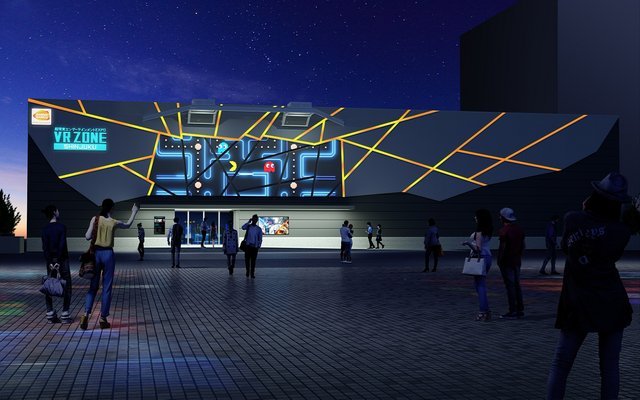
Bandai Namco’s VR Zone Shinjuku
Another Japanese amusement game factory that has invested in this technology is Bandai Namco Games, initially last year with a test facility under the VR Zone: Project i Can VR Zone. The company has amassed valuable research from this first deployment and created a brand-new offering. With the launch in July of VR Zone Shinjuku, this flagship covers 40,000 sq. ft. and comprises some 15 different VR attractions. Most notedly was the announcement the venue would have Mario Kart GP VR, a highly physical VR cockpit version of the amusement racer series, licensed and developed with Nintendo.
This is not the only VR experience developed by Bandai Namco for their new VR facility that borrows heavily on their amusement hardware roots. They’ve also got a VR fishing game, pedalling experience and a cockpit-based robot combat game, to name a few. Bandai Namco’s aspirations are to open several VR Zones in Japan, and already confirmed that they are making plans to develop the concept for Europe and North America.
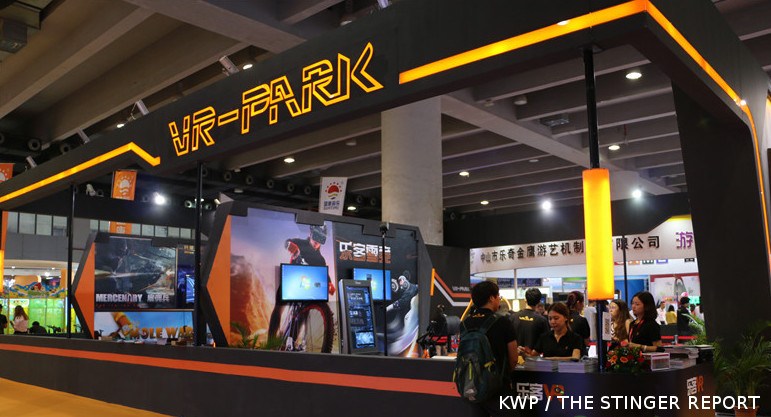
Adores’ VR Park Tokyo
A prominent Japanese amusement operator, Adores Corporation, in partnership with major mobile game developer GREE, has created its own interpretation of what this technology can offer destinations, opening its VR Park Tokyo last year. Building on Adores’ amusement site experience, this flagship location offers a unique number of purpose-built VR attractions.
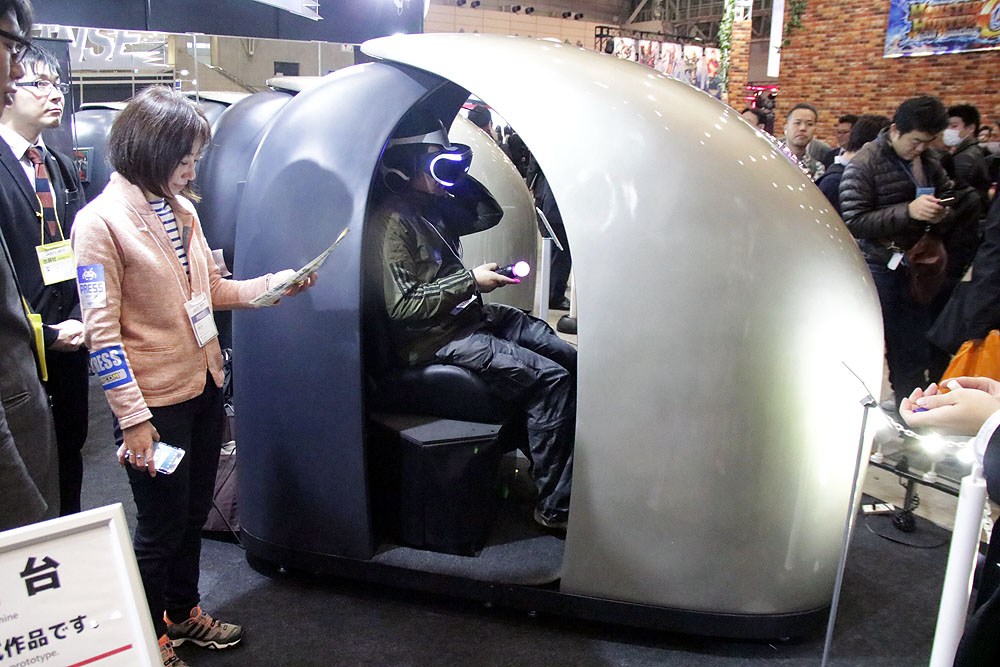
Koei Tecmo Group’s VR Sense virtual reality game pod on exhibit at the JAEPO show (photo: Arcade Heroes).
Many other Japanese amusement facility operators have investment in projects to evaluate how best they can enter the VR scene, while other manufacturers look to create their own VR amusement hardware. At the beginning of the year in Japan, Koei Tecmo Group launched their VR Sense, a virtual reality arcade pod that offered through a Sony PSVR headset and a physical effects seat, several VR experiences based on popular Tecmo brands.
Another Asian amusement developer that has dialed into the development of standalone VR amusement applications is UNIS (Universal Space), which in partnership with VR omni-direction hardware manufacturer Virtuix, has set up a brand-new division called Fun VR Tech. Initially this division will be selling the Omni Arena VR, a two- or five-unit platform that offers a network VR experience suitable for amusement and attraction deployment. With the new division, the company hopes to distribute active VR experiences to the commercial entertainment market, driving a move towards a new way of playing, not just in the Asian sector. They are already deploying this platform with North American facility operators.
Bringing the Concept to the West
From the perspective of dedicated venues running VR games, much has been learned from the Chinese approach, married to extensive research and development in the Western amusement and attraction scene.
The cinema sector has not been slow to jump into this water, and movie giant IMAX has invested in creating their own VR arcade franchise. The IMAX VR center concept was first opened last year in Los Angeles, and using figures up to March of this year, has reported over 20,000 unique visitors to this pilot facility. This has spurred them into rolling out the attraction at additional venues (the most recent at press time being within New York’s AMC Kip’s Bay 15 cinema). IMAX VR favors a design with unique enclosures in which players pay-to-play a selection of VR games. Some of these are converted consumer content, while others are specially created movie tie-ins, like the new The Mummy Prodigium Strike, location-based VR game. Developed by Starbreeze Studios, The Mummy utilizes the 210-degree virtual reality StarVR headset, made exclusively for commercial application.
This pay-to-play VR arcade approach has seen much interest from start-up entrepreneurs, but this approach can be fraught with danger. One of the established VR arcade chain operators in North America is VR Junkies, with some six locations opened and a growing number in development. The company in recognizing the pitfalls of opening a VR arcade, decided to create a solution through its sister company, Private Label VR. What they provide is described as a “business in a box” solution to out-of-home entertainment venues wanting to run VR operations, whether that be a game room or bar/tavern location.
Other facilities popping up in this sector include CTRL V and Upward VR to just name two of many – all offering an entertainment environment to experience commercialized VR game content, but inevitably using improvised consumer VR hardware.
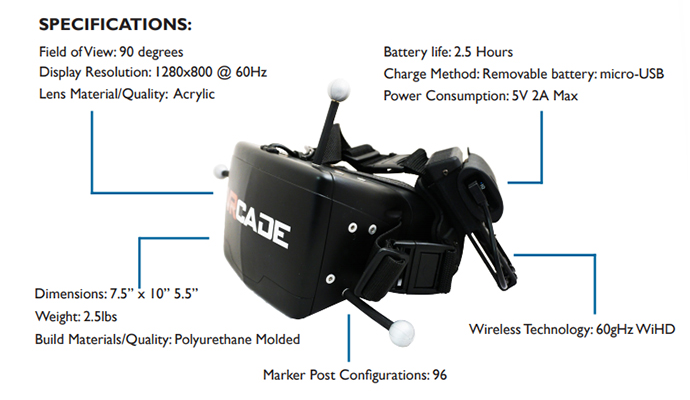
VRStudio’s unique and untethered headset.
An early developer of sophisticated VR entertainment is Seattle-based VRStudios. Using a unique, untethered VR headset and gun interface, the company’s VRcade platform has been installed in some 40 locations around the world. Recent developments have seen the company create a new VRcade Arena System that enables a greater level of engagement. The new system offers up to eight players to play simultaneously within a virtual experience using their non-backpack, wireless technology. The latest VRcade system is seen as a turnkey solution for the deployment of VR entertainment in a new phase of development within location-based entertainment. It offers what has been called “warehouse-scale,” or “Arena-Scale” VR experiences, using wireless or backpack-worn computer and HMD configurations to free-roam around specially themed environments. We are observing several new manufacturers championing the adoption of this approach to the business that some have called “VR laser tag.”
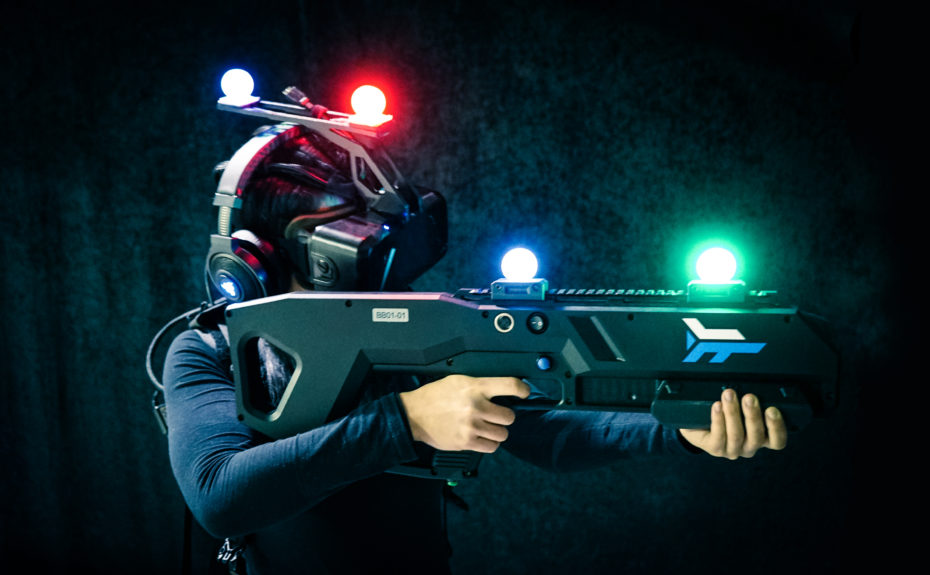
Zero Latency has upped player throughput in their arena-scale VR environments by increasing the simultaneous players from six to eight.
Certainly one of these champions of warehouse-scale VR systems is Australian-based Zero Latency. Over the last few years, they’ve developed a reliable and highly competitive platform, accommodating multiple backpack- and headset-wearing players. Since the company’s first arena in Melbourne, Australia, in 2015, they’ve placed sites in Tokyo, Madrid, Orlando, Wisconsin Dells, Pocono Mountains, the greater Tulsa area and Scottsdale, Az., with more in the works. Zero Latency has certainly not stood still in developing arena-scale VR experiences and recently announced that up to eight players can now simultaneously play their latest games at one time (a boost from the original six). Zero Latency games can be deployed in 2,000- to 4,000-sq.-ft. arenas; increased throughput directly affects the bottom line.
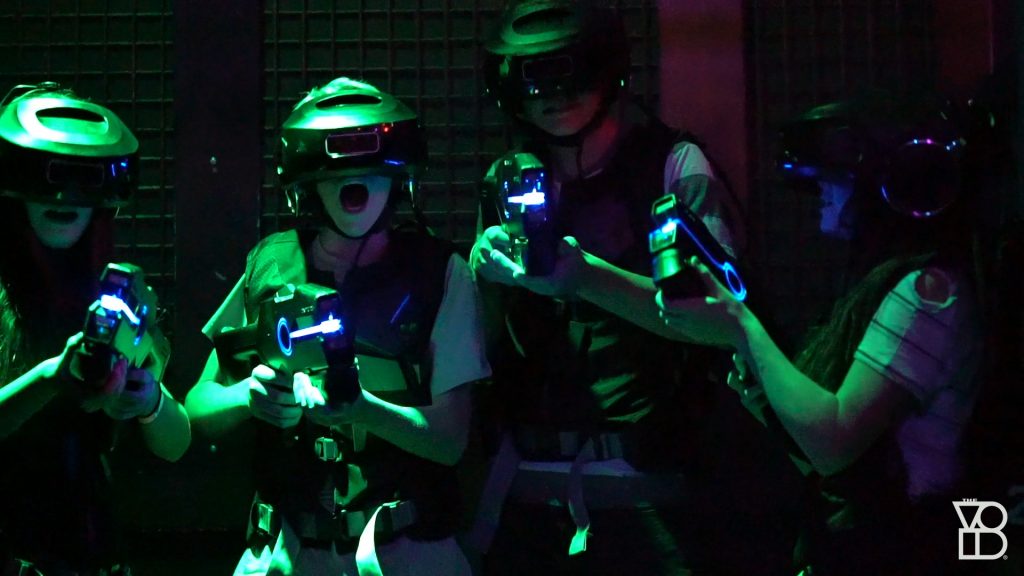
The Void has deployed its Ghostbusters Experience to other locations. The first installation was at Madame Tussaud’s in New York City.
One of the well-publicized developers of VR backpack experiences has been The VOID, the company promoting its “Hyper Reality” platform that married a free-roaming, backpack-based VR system with a physical show-set that includes real items (like walls, furniture, etc.) represented exactly in the virtual environment. The corporation partnered in 2015 with Sony Pictures and Madame Tussauds (the famous wax museum) to develop the Ghostbusters Experience, transporting “Proton-Pack”-wearing guests through a VR attraction based on the movie property. Since the launch of the first venue running the Ghostbusters Experience at Madame Tussauds’ New York facility, the attraction has been installed by The VOID at three other sites: Dubai, Utah and now Toronto. (That latest Ghostbusters installation is in partnership with Canada’s Cineplex Entertainment and is in its 40,000-sq.-ft. Rec Room entertainment facility in Toronto.)
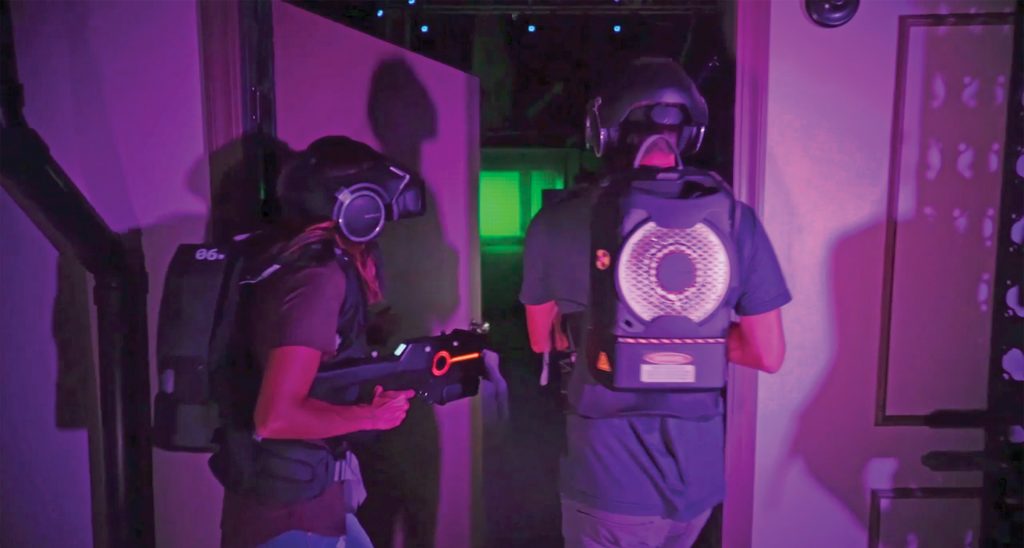
Players at Cineplex’s Rec Room in action in The Void VR Ghostbusters Experience.
But Wait! There’s More!
We must be keen to not become fixated that immersive experiences are limited to VR. Another key technology influencing DOE business today is immersive projection. This platform addresses many of the limitations of headsets deployed within a large throughput entertainment environment (such as hygiene, reliability and comfort).
New platforms offer a compelling and wholly immersive experience using projection. One of the first developers of the current generation of standalone projected enclosure experiences is the French-based Scale-1 Portal, with their VOXEL platform. It uses 3D visuals within a body-tracked projected enclosure, pulling the player into the game experience. Other developers include Australia-based Euclideon Entertainment, which began operation of its Holoverse facility on the Gold Coast last year. The Holoverse comprises some 40 “hologram rooms” where the latest projection a computer graphics technology transports the user into immersive universes.
Learning More
This hopefully gives you a snapshot of the diverse and compelling new entertainment sector that, though borrowing the approach of amusement, is most defiantly ploughing its own furrow in the sector. It is important to understand the crossover between what the traditional amusement industry must offer, and where the “Digital Out-of-Home Entertainment” industry with its broad areas of interest hopes to travel.
To that end, the first dedicated conference and exhibition based on this industry is scheduled to take place September 13-14 at the Mandalay Bay resort in Las Vegas. The Future of Immersive Leisure (FOIL) event will see prominent executives from the various industries giving their views on the scene, and demonstrating the latest development. RePlay Magazine is a media sponsor of the event; readers can get a 15% discount by using the code REPLAYMAG when registering. Learn more at www.futureofimmersiveleisure.com.
Kevin Williams has an extensive background in the development and sales of the latest amusement and attraction applications and technologies. The U.K.-born specialist in the pay-to-play scene is well-known and respected through his consultancy KWP and as a prolific writer and presenter. He publishes The Stinger Report, which covers the emergence of the new entertainment maket, and has co-authored a book called The Out-of-Home Interactive Entertainment Frontier. He’s also the founding chairman of the DNA Association, Which focuses on digital out-of-home interactive entertainment. Kevin can be reached at kwp
@thestingerreport.com.


